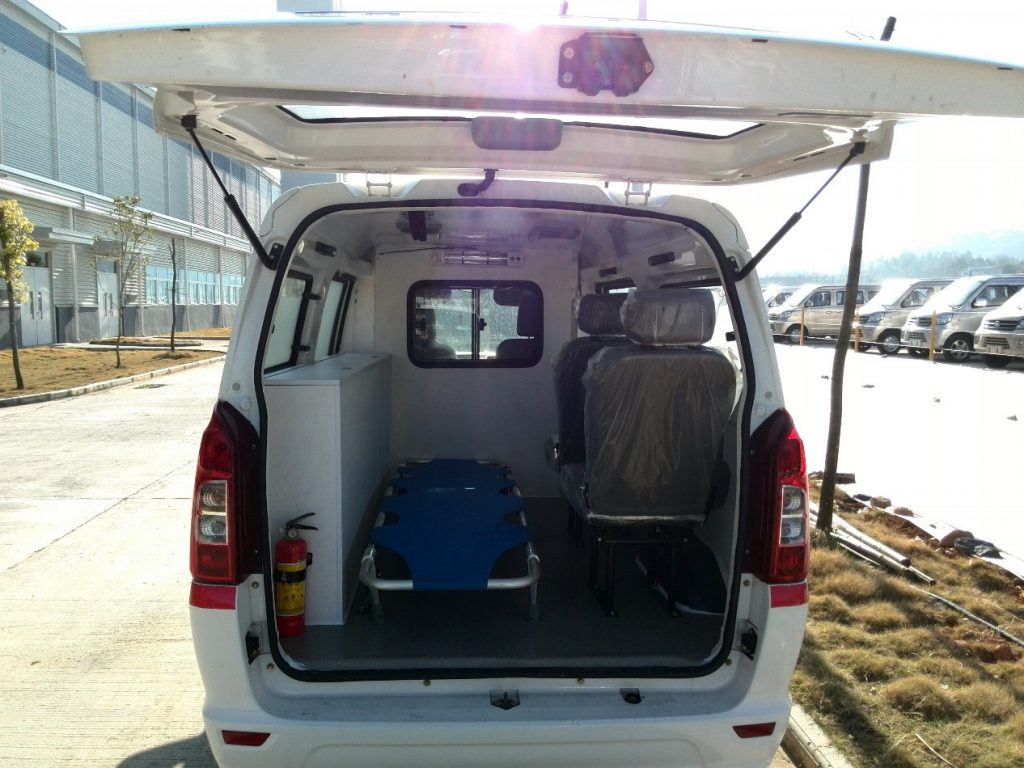Price of J5 ambulance is around 30,000 to 40,000 according to various configurations.
Parameters:
| Engine Model | Emission | Displacement | Rated output( kw/rpm) | Max. torque (N.m/rpm) | Seats | length*width*height(mm) |
| diesel engine | EURO IV | 2.498L | 100/3800 | 260/1800-2600 | 6 | 5380*1880*2440 |
| Wheelbase (mm) | Capacity of fuel tank(L) | Clutch | Transmission | Tire | Brake system | Suspension |
| 3110 | 70 | single disc, hydraulic control | manual 5 speeds, flexible shaft control | 195R15C radial tire | disc/ drum, ABS+EBD, initiative vacuum booster | front double wishbone independent suspension/ rear variable rate leaf spring |
Exterior
| power driver & co-driver window, power wing mirror, anti-glare inner rear view mirror |
| intermittent front wiper, front washer, |
| rear wiper, rear electric defroster, rear washer |
| remote control center door lock |
| reverse radar, high mount brake lamp |
| tiltable steering wheel, sun visor with mirror |
| white and opaque tearing foil on 2/3 of medical cabin window |
| reflective strip in 3 meters length on the body and front face |
| international aid mark, exterior roof light bar (100W), LED quadrate strobe light |
| manual sliding door |
| UV-locking glasses(driver & co-driver) |
| full closed passenger window, rear side dark gray glasses |
| combination lamp, chrome-plated grill |
| 4 aluminum wheels, 1 steel spare tire |
| sliding driver & co-driver seat |
| plasma air cleaner (1 piece) |
Medical Equipment
| full closed partition wall with sliding window between driver cab and passenger cabin |
| special floor for medical, roof ventilation in medical cabin, roof handrail |
| drawer type medicine cupboard, multi-functional medical cabinet |
| doctor and nurse seats |
| luxury light bar, electronic alarm, exterior flashing lamp |
| medical lighting system, Ultraviolet disinfection lamp, rear reflector lamp |
| oxygen system |
| inverter system, maintenance-free storage battery |
| mandatory ventilation system |
| functional control panel, trash can |
| stretcher trolley, shovel stretcher, transfusion bracket on the roof |
Ambulances minibusses are vehicles that help patients. The word “AMBULANCE” was written the other way around. Therefore drivers in front of them could see the word “AMBULANCE” in the direction of their rearview mirror and move out of the way quickly.
With the flashing of warning lights and the whistling of sirens, there is no doubt that an ambulance is rushing to the scene of an emergency call. All traffic arteries magically allow it to pass. Drivers can drive on the edge of the roadway, on the sidewalk, or even on the other side of the road. As long as an ambulance can pass. Like firefighters on the scene of a fire, paramedics have to race against the clock. Because it can mean the difference between life and death.

1. History of the ambulance:
Ambulances have changed dramatically over the past 40 years. Until the late 1960s, the main task of ambulances was to transport people from the scene of an accident to the hospital as quickly as possible. The interior of the car is very uncomforatble, with only some very basic first aid equipment. Since then, however, there have been changes in ambulances and ambulance crews.
2. Application of ambulance:
The interior of modern ambulances is more spacious, allowing crews to treat patients on the way to the hospital. Modern ambulances also carry a large number of bandages and dressings inside to help stop bleeding, clean wounds, and prevent infection.
The car also carries splints and braces to secure the broken limb and prevent further neck and spine injuries. Oxygen, a portable ventilator, and a defibrillator are also available. Most ambulances also carry patient monitors that monitor a patient’s pulse and breathing on the way to the emergency room.
Many modern ambulances are staffed by professional first responders. Especially those working in high-risk situations such as major sporting events or busy sections of highways. They are able to provide a high level of emergency treatment. Their professional aid on the spot and en route can often save the life of the injured. They are trained to diagnose patients’ injuries. Therefore, they can radio data ahead of time and advise hospitals on which medical staff and technicians to prepare and prepare surgical equipment.

 Mini Bus
Mini Bus